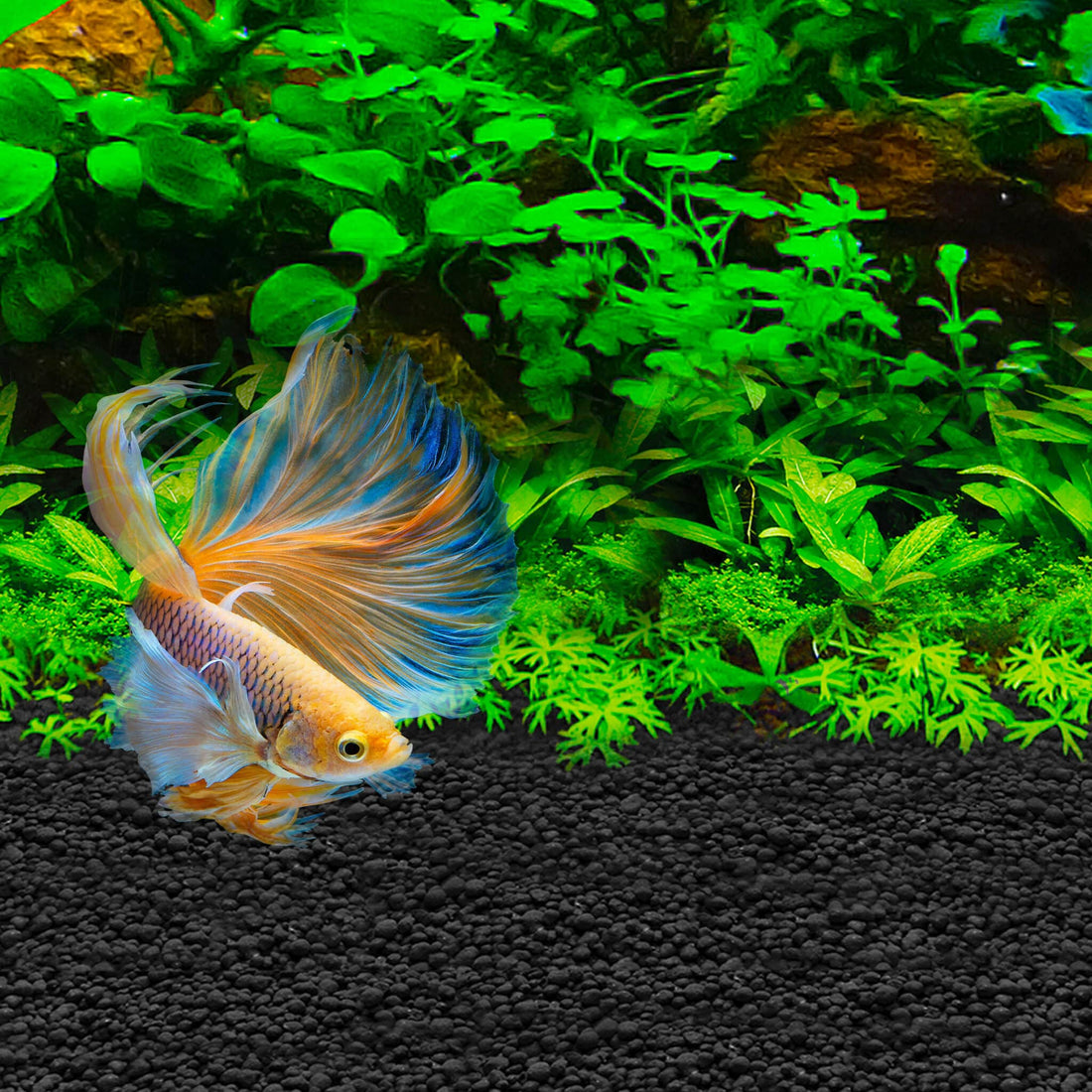
The 7 Absolute Fundamentals for (Most) Aquariums
Share
So, you've just picked up your first aquarium. It's sitting on your counter, looking shiny and new, and you're probably already dreaming about all the fish you're going to put in it. Before you get to the fun part, though, there are a few foundational principles you absolutely need to know.
These aren't just suggestions; they are the 7 absolute fundamentals that will save you from a lot of frustration—and help your fish thrive. At Pond Life Aquatics and Tropical Fish London, we’ve been helping people keep fish successfully since 2005. With over a century of combined experience among our staff, and my own two decades of trial-and-error, we know firsthand that mastering these basics is the single most important step you can take. Ignore them, and you’re setting yourself up for disappointment; learn them, and you're well on your way to becoming a confident, successful fishkeeper.
A quick note: These fundamentals apply to the vast majority of aquariums but may not apply to specialized setups like dirted or Walstad method aquariums.
1. Always Keep Your Heater Switched On
The water temperature in a tropical aquarium is not a luxury—it's a fundamental pillar of health. A consistent temperature, free from dramatic swings, greatly reduces stress on your fish and invertebrates. This stress reduction is your first line of defense against common diseases like ich and ensures a stable environment for beneficial bacteria.
A major mistake we see at Pond Life Aquatics is when people forget to turn their heater off during a water change. If the heating element is exposed to the air while still hot, it can crack, rendering the heater useless. Worse, a faulty heater can stick in the "on" position and overheat your tank, with tragic consequences. Always make sure you unplug your heater and let it cool for a few minutes before starting any maintenance.
As for the right temperature, it’s simple: for a species-only tank, aim for the median temperature range for that specific fish. For a community aquarium, a good rule of thumb is to set your heater to 24°C (75°F), which is a safe bet for most common community species. Finally, always have a separate thermometer in your tank. Check it daily to ensure your heater is working correctly. A few seconds of observation can save you from a major issue.
2. Always Keep Your Filter Switched On
If the heater is the heart of the aquarium, the filter is the lungs and kidneys. It’s far more than a device for "clean" water. It performs three critical functions: creating circulation for oxygen and CO2 exchange, removing physical detritus, and, most importantly, providing a home for your beneficial bacteria. This is the biological part of your filter that converts toxic fish waste (ammonia and nitrite) into less harmful nitrate.
Turning off your filter for an extended period is one of the most catastrophic mistakes a new hobbyist can make. After just a few minutes without flow, the beneficial bacteria begin to die off, and the trapped fish waste starts to rot, poisoning your tank. An easy sign that something is wrong is if your fish are constantly gasping at the surface—this is often a sign of a lack of oxygen caused by poor flow.
When it comes to maintenance, there is a golden rule: Never wash your filter media in tap water. Tap water contains chlorine or chloramine, which is great for us but deadly to the beneficial bacteria in your filter. Instead, use a dedicated bucket and clean your sponges and media in the old tank water you've siphoned out during a water change. This way, you remove the physical waste while keeping your vital bacteria colony intact.
3. Keep a Timer on Your Lights
Consistent light is crucial for a balanced aquarium. It's not just about seeing your fish; it provides a consistent day/night cycle that fish and plants rely on. The easiest way to achieve this is with a simple socket timer attached to your aquarium light. Personally, I find Wi-Fi plugs to be the most convenient, as they offer precise control and easy adjustments from your phone.
A great place for a beginner to start is with an 8-hour photoperiod. This can be done in a single block or, as I prefer to do it myself, in a split schedule (e.g., 4 hours on in the morning, a few hours off, and 4 hours on in the evening). The key is to be consistent.
You can and should adjust your lighting schedule based on what you see in your tank. If your plants look pale or "leggy," slowly increase the time by an hour over a few weeks. If you're experiencing aggressive algae growth, drop your lighting period by an hour. The one thing you should never do is leave your lights on 24 hours a day. This is a guaranteed recipe for disaster, as it will lead to explosive algae growth that can choke out your tank and turn the water into an unsightly, murky green.
4. Always Top Up with Dechlorinated Water
This is a simple rule with fatal consequences if ignored. Tap water contains chlorine or chloramine, chemicals added by water companies to make it safe for us to drink. However, these same chemicals are deadly to your fish and will instantly wipe out the beneficial bacteria in your filter. This is true whether you're performing a large water change or just topping off water lost to evaporation, so always dechlorinate your water, no matter what.
We recommend having a dedicated bucket for this purpose, preferably one with liter markings on the side. When performing a water change, you can see exactly how much water you've removed and replace it with the correct amount of dechlorinated water. Just add the conditioner to the bucket, mix it by hand, and then add it to your tank. For quick top-ups, a few liters of pre-dechlorinated water kept in a sealed container will make your life much easier.
When choosing a dechlorinator, always go for a reputable brand you can trust. We personally use NT Labs Optimus at Pond Life Aquatics, but other major brands like Seachem Prime, Tetra, and API are also excellent. A major benefit of these quality products is that they don't just remove chlorine and heavy metals; many of them also actively detoxify ammonia in the water column, giving your aquarium an added layer of protection.
5. Always Use a Biological Booster After Servicing
A biological booster is exactly what it sounds like: a product that replenishes and fortifies the colonies of beneficial bacteria in your aquarium. No matter how careful you are with your maintenance, some of this vital bacteria will inevitably be lost or disturbed during a water change or filter cleaning. A booster helps to quickly replenish them, ensuring the biological balance of your tank remains stable.
This is especially critical if you accidentally made the mistake of washing your filter in tap water. While it's a disaster you should always avoid, a good biological booster can help re-establish your bacterial colony and prevent your aquarium from experiencing a full-on "crash."
At Pond Life Aquatics, we believe in playing it safe. We recommend using a biological booster after every water change or major filter clean. Think of it as an affordable insurance policy that keeps your aquarium as healthy as possible and gives you peace of mind.
6. Perform a 15-20% Water Change Per Week
A regular water change is the single most important routine maintenance you can perform. The primary goal is to keep the levels of nitrate in your aquarium low. As ammonia is broken down by your beneficial bacteria, it eventually converts into nitrate, which can build up to toxic levels over time. If you don't have a test kit to check for this, common signs that your nitrates are too high include fish flicking due to gill burn, lethargy, or, in the worst cases, death.
While the primary benefit is clear, weekly water changes provide several other important benefits for a healthy ecosystem. They help to replenish essential minerals that your plants require for growth, provide an excellent opportunity to siphon up excess fish waste and dead plant leaves from the substrate, and can even simulate rainfall for some species, which can trigger them to start breeding.
7. Service Your Mechanical Filtration Every 1-2 Months
While your biological filter should largely be left alone, your mechanical filtration—the sponges or pads that physically catch waste—needs to be serviced regularly to prevent it from clogging. The primary sign that your filter needs a good clean is if its flow is visibly slowing down. If you neglect this for too long, the filter won't be able to effectively draw water, which will quickly lead to a deterioration in water quality and can even damage the filter itself.
Based on our experience at Pond Life Aquatics, a simple process is to perform a slightly larger than average water change and use the removed tank water to clean your filter media. Since the water can quickly become soiled, a great tip is to do this in "batches" with fresh, siphoned water. Give your mechanical sponges a thorough squeeze and rinse to remove all the trapped waste. For your biological media, a quick shake off in the relatively clean tank water is all that is needed. Remember, this beneficial bacteria is the most important part of your filter, so try to avoid handling it too much.
Conclusion
If you follow these 7 basic fundamentals of keeping an aquarium, you're well on your way to successfully keeping a happy and healthy aquarium. If you have any questions about keeping your aquarium happy and healthy, then feel free to get in contact with us or come down and see us at 1 Finchley Nurseries, London, NW7 1AS. Thanks for reading,
Harris Bard, Pond Life Aquatics
